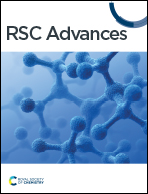One pot tandem dehydrogenative cross-coupling of primary and secondary alcohols by ruthenium amido-functionalized 1,2,4-triazole derived N-heterocyclic carbene complexes†
Abstract
One-pot tandem dehydrogenative cross-coupling of primary and secondary alcohols was catalyzed by three ruthenium complexes [1-(R)-4-N-(furan-2-ylmethyl)acetamido-1,2,4-triazol-5-ylidene]Ru(p-cymene)Cl [R = Et (1b), i-Pr (2b), Bn (3b)], of amido-functionalized 1,2,4-triazole derived N-heterocyclic carbene (NHC) ligands. Density Functional Theory (DFT) calculations were employed for the ruthenium (1b) precatalyst to understand this reaction mechanism completely, and the mechanisms adapted are divided categorically into three steps (i) nucleophilic substitution of chloride ions by alcohols, (ii) dehydrogenation of primary and secondary alcohols, and (iii) olefin and ketone hydrogenation. Our mechanistic study reveals that the formation of a deprotonated Ru–alcoholate (A) or (E) intermediate is favorable compared to the protonated form (A′) or (E′) from (1b) by associative nucleophilic substitution. Though an ionic pathway that proceeds through (A′) or (E′), has less barriers in the dehydrogenation and olefin/ketone hydrogenation steps than that of the neutral pathway, proceeding through (A) or (E), a steep energy barrier was observed in the first nucleophilic substitution step, prohibiting the reaction to proceed via the intermediate (A′) or (E′). Thus, our thorough mechanistic study reveals that the reaction proceeds via deprotonated Ru–alcoholate (A) or (E) species. Furthermore, the 1,4 addition of an α,β-unsaturated carbonyl compound is kinetically and thermodynamically favorable over the 1,2 addition, and the experiments support these observations. As a testimony towards practical application in synthesizing bio-active flavonoid based natural products, five different flavan derivatives (16–20), were synthesized by the dehydrogenative coupling reaction using the neutral ruthenium (1–3)b complexes.



 Please wait while we load your content...
Please wait while we load your content...